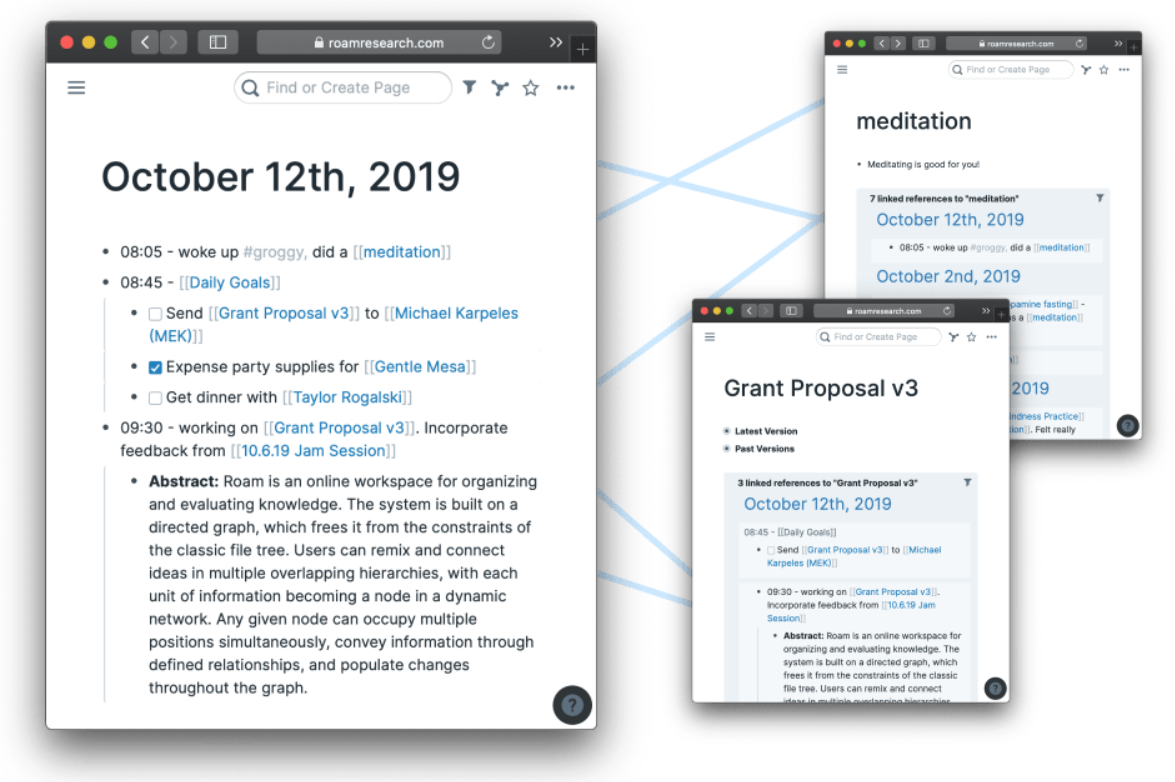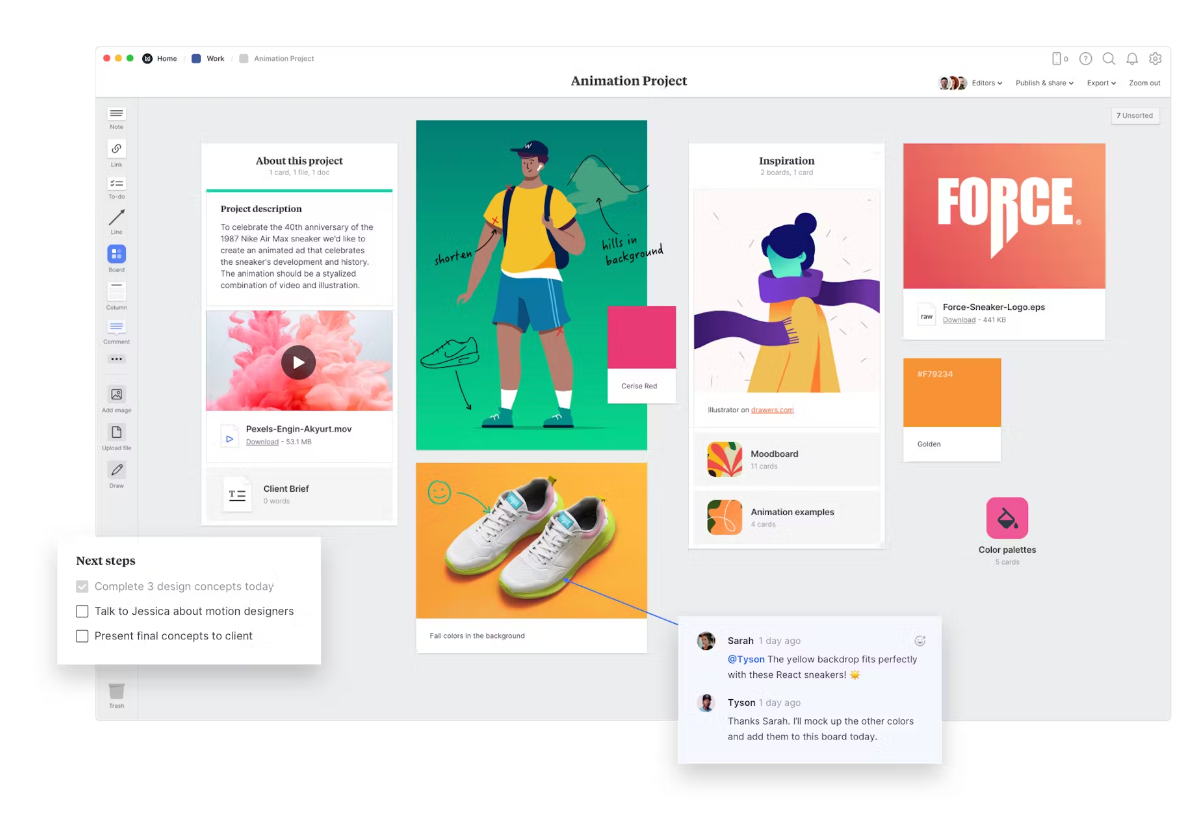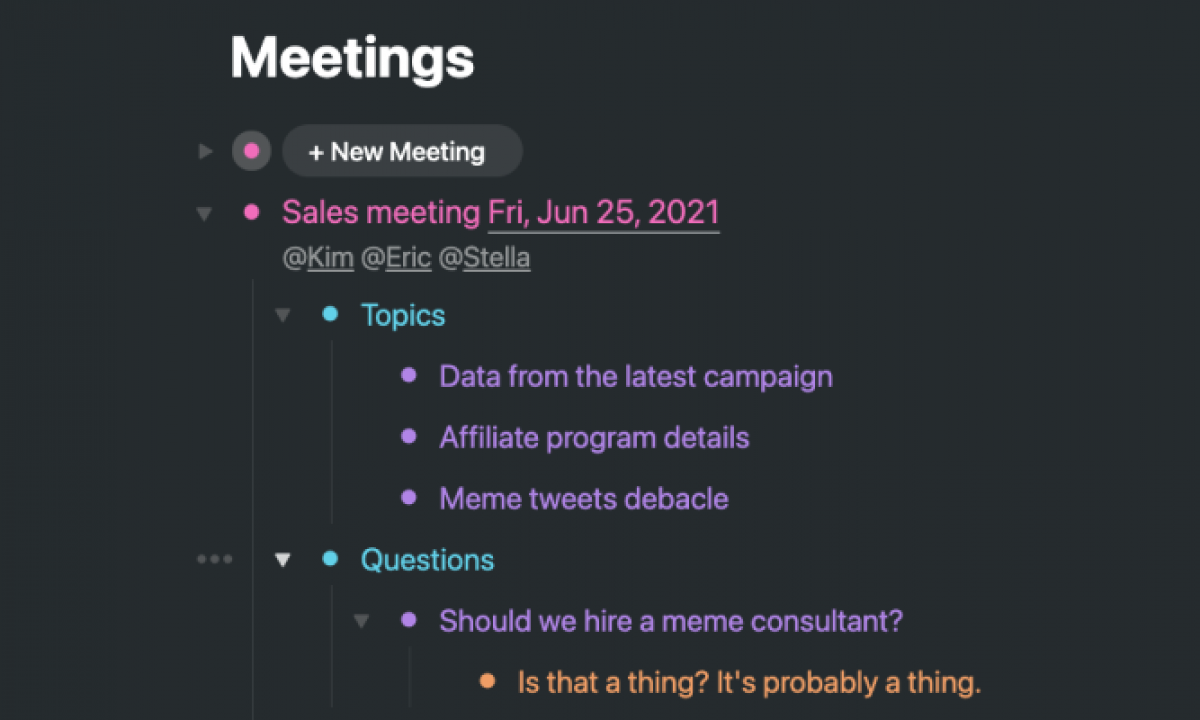13 Best Tana Alternatives for Note-Taking in 2025

Sorry, there were no results found for “”
Sorry, there were no results found for “”
Sorry, there were no results found for “”

With its mix of structured notes, daily logging, and a slick outliner-style interface, Tana has become a popular tool for people who think deeply about how they organize information. For creators, students, and knowledge workers, Tana offers structure and flexibility within a single note-taking app.
But while Tana is impressive, it’s not for everyone, and it’s not the only option out there.
Whether you’re after more visual thinking, AI assistance, better task integration, or a simpler way to manage your ideas, there are plenty of powerful alternatives worth exploring.
In this blog, we’ll explore the best Tana alternatives, from all-in-one productivity platforms like ClickUp to PKM-first tools like Obsidian, Logseq, and Capacities. Whether you’re an individual creator or a team, there’s a tool here that fits your workflow, style, and budget.
Tana is a standout when it comes to structured note-taking and knowledge graph creation. Its node-based architecture and “everything is a reference” philosophy give power users the freedom to build complex, interlinked systems of thought. But it’s not without its limitations.
Here are a few reasons why you might be looking for a Tana alternative:
That’s why we’ve curated the best Tana alternatives that not only support powerful note-taking but also empower productivity, collaboration, and knowledge management.
To help you quickly compare, here’s a snapshot of the best alternatives to Tana:
| Tool | Best Features | Best For | Pricing* |
| ClickUp | Docs with nested pages, tasks + notes in one place, AI Notetaker, real-time collaboration | Best for individuals, teams, and enterprises needing a powerful all-in-one workspace | Free plan available; Add-ons and customizations available for enterprises |
| Roam Research | Bidirectional linking, daily notes, graph-based interface | Best for researchers and writers who thrive on networked thinking | Starts at $15/month; No free plan |
| Obsidian | Local-first storage, Markdown support, robust plugin ecosystem | Best for privacy-focused users and solo knowledge workers | Free for personal use; Paid plans start at $50 |
| Logseq | Local graph, outliner-based structure, open source | Best for developers and academics who prefer customization and privacy | Free; Open source |
| Workflowy | Infinite nested lists, clean interface, tagging system | Best for minimalists and solopreneurs who need simple, structured outlining | Free plan available; Paid plan starts at $8.99/month |
| RemNote | Spaced repetition, linked notes, flashcard integration | Best for students and lifelong learners who want to retain knowledge | Free plan available; Pro features start at $8/month |
| Anytype | Local-first, offline-first, graph-based knowledge OS | Best for privacy-focused creators building structured personal knowledge systems | Free plan available; Paid starts at $99 per year |
| Notion | Rich content blocks, templates, databases, and integrations | Best for cross-functional teams and solo users managing notes, wikis, and projects | Free plan available; Paid plans start at $12/month |
| Coda | Interactive docs, building blocks for apps, data tables | Best for product and operations teams managing data and workflows in docs | Free plan available; Paid plans start at $12/month |
| Heptabase | Visual note-taking, spatial canvases, research-focused features | Best for researchers and visual thinkers mapping complex ideas | Free trial available; Paid plans start at $11.99/month |
| Capacities | AI-powered knowledge graph, media embedding, tags and properties | Best for creators and solo professionals managing diverse digital content | Free plan available; Paid plan starts at $11.99/month |
| Mem | AI-surfaced notes, smart organization, calendar integration | Best for busy professionals who want an automatic, low-effort note system | Free plan available; Paid plans start at $8.33/month |
| Milanote | Visual boards, drag-and-drop interface, creative-friendly templates | Best for designers and creative teams organizing ideas visually | Free plan available; Paid plans start at $9.99/month |
ClickUp is an all-in-one productivity platform designed for teams and individuals who want to streamline note-taking, task management, and knowledge sharing in a single workspace.
With ClickUp, you can create structured Docs with nested pages, manage tasks and notes side by side, and leverage powerful AI tools to boost your workflow.
ClickUp Docs allows you to create, organize, and share documents with nested pages, making it easy to build knowledge bases, meeting notes, or project documentation. You can embed tasks directly within Docs, link related documents, and collaborate in real time with your team.
ClickUp’s AI Notetaker helps you capture meeting notes, summarize lengthy documents, and generate action items automatically. This feature is especially useful for teams that want to save time on manual note-taking and ensure nothing falls through the cracks.
ClickUp’s advanced AI assistant, ClickUp Brain, takes things a step further. You can use it for writing assistance, smart suggestions, sorting your exam preparation notes, creating summaries for your meeting, and even transforming sticky notes into rich notes.
ClickUp’s built-in Notepad is perfect for jotting down quick ideas, to-dos, or reminders. You can easily convert notes into actionable tasks or add them to Docs for more context.

⚡️Template Archive: Free Knowledge Base Templates to Create your Information Library
💡Pro Tip: Streamline your meetings and make them productive for everyone with ClickUp’s Meeting Notes Template, which includes agendas, notes, and action items.
What are real-life users saying about ClickUp?
I used to live by my written notes, but after two days of evaluating ClickUp, I knew it was the solution for me

Roam Research offers a non-linear approach to note-taking, focused on building connections between ideas through bi-directional linking. It’s tailored for users who want to capture thoughts organically and revisit them as part of a growing web of knowledge.
Roam encourages daily writing and natural relationship-building between notes. This is especially useful for long-term thinkers, researchers, writers, and content creators who want to trace how ideas develop over time and uncover patterns between topics.
Roam introduced me to networked linking and this amazing way of taking notes. Everything is to the point and you don’t lose time in random features. Simple and clean note taking. However, I don’t like the pricing model compared with other tools available on the market.

Obsidian is a good choice if you want full control over all your data and workflows. It’s built around a local-first approach, meaning your notes are stored directly on your device instead of the cloud. This makes it appealing for users who prioritize privacy or want to work offline without limitations.
The app is highly modular, with a strong community contributing plugins that extend its functionality beyond traditional note-taking.
📖 Also Read: Best Obsidian Alternatives for Note Taking
I think Obsidian is ideal for text-centric tasks, and it excels at note-taking and daily task tracking. However, it’s missing the ability to create forms, which might be a bummer for me. Setting up team collaboration isn’t a walk in the park either—it lacks seamless integration for smooth group work.
📖 Read More: How to Take Notes from a Video Like a Pro

Logseq is a privacy-focused, open-source note-taking app that stores your notes locally. It appeals to users who want data control and prefer an outliner-style approach to organize ideas.
The app is especially suited for people building personal knowledge bases or those who favor offline access and a text-first workflow.
Logseq is brilliant in theory, painful in practice. It’s a powerful local-first, markdown-based outliner, but once your graph gets big, performance tanks, and structured data becomes a mess.
📖 Read More: How to Share and Collaborate on Notes

RemNote is designed for learners and knowledge workers who want to combine note-taking with active recall through spaced repetition. It focuses on helping users remember information by linking notes directly to flashcards, making it a solid choice for anyone managing complex learning material.
The app supports hierarchical outlines and bi-directional linking, enabling users to build interconnected knowledge bases. Its approach blends note-taking and studying in one platform, helping you retain key concepts more efficiently over time.
I do love the concept and functions of this APP, but to be honest, its user interface really needs further embellishment.
📮 ClickUp Insight: While 34% of users operate with complete confidence in AI systems, a slightly larger group (38%) maintains a “trust but verify” approach. A standalone tool that is unfamiliar with your work context often carries a higher risk of generating inaccurate or unsatisfactory responses.
This is why we built ClickUp Brain, the AI that connects your project management, knowledge management, and collaboration across your workspace and integrated third-party tools.
Get contextual responses without the toggle tax and experience a 2–3x increase in work efficiency, just like our clients at Seequent.

Anytype is a decentralized note-taking and knowledge management app built with privacy and security in mind. It stores your data locally and syncs it peer-to-peer, making it an attractive option for users who want to avoid cloud-based storage and retain control over their information.
The app supports rich content types and customizable templates, appealing to creators and teams looking for flexible ways to organize projects, notes, and workflows without relying on centralized servers.
Been using it since December and I gotta say I love what Anytype is doing! There are minor bugs here and there but it’s been an awesome experience and very refreshing UI.

Notion is a versatile collaborative note-taking tool known for its customizable workspaces. It combines notes, databases, and project management features into a single platform. Users can build interconnected pages, track projects, and organize content using various view options.
It also includes pre-built templates to streamline workflows and enhance team collaboration. Additionally, Notion’s built-in AI helps with tasks like searching, summarizing, and translating notes efficiently.
I liked being able to leave notes written on the document. It always notified us when someone else made changes or added to the project. It was an easy way to keep everyone on the same page. However, Notion was not very user-friendly. I feel like it took our team a while to figure out how to effectively use the program.

Coda combines documents and spreadsheets into a flexible platform where users can build custom workflows with interactive elements. It suits teams and individuals who want to create unique solutions tailored to specific processes, without relying on multiple disconnected tools.
With its modular approach, Coda allows embedding tables, buttons, and formulas directly into docs, making it useful for managing complex data alongside narrative content.
It has tons of possibilities. You can write documentation, create (complex) tables, create pages inside pages, mention people and pages, integrate with miro, google sheets/docs/etc, insert images, links. Some features and possibilities are not very clear and intuitive. Although the interface is very user-friendly, you have to figure out how to use certain functions.

Heptabase is designed for creators, researchers, and knowledge workers who thrive with visual thinking. It offers a unique spatial approach to note-taking, allowing users to organize ideas using cards on a whiteboard-style interface.
This visual layout helps simplify complex topics, making it easier to explore, connect, and reflect on information.
I can now say in two weeks with Heptabase I’m a far better note taker than I’ve ever been. The mobile app has improved some, but it still has serious impactful limitations.

Capacities is designed to enhance personal and team knowledge management using AI. It helps users organize, search, and retrieve information efficiently by combining traditional note-taking with AI-driven insights.
The platform supports natural language queries and automatically surfaces relevant content, which can save time for knowledge workers who manage large volumes of information. Its focus on AI makes it an interesting option for those looking to boost productivity through smarter information retrieval.
I love Capacities! I have started using it in tandem with Notion for all of my notes and knowledge management. It also just loads SO MUCH FASTER than Notion, which has been almost unusably slow on my end.
➡️ Read More: How to Implement Collaborative Note-Taking Strategies

Mem focuses on using AI to help users capture, organize, and find notes effortlessly. It automatically organizes your content, making connections between ideas without much manual tagging or structuring. This makes it a good fit for knowledge workers and creators who want a smart note-taking experience.
The app emphasizes speed and minimalism, allowing quick capture of ideas and real-time search powered by AI. Its design supports continuous knowledge growth by highlighting related content and surface relevant notes as you work.
I have used Mem from the beginning and it’s still my choice for quick notes and to find information quickly.

Milanote is designed for creatives who think visually. It offers a flexible board-style workspace ideal for mood boards, project planning, and brainstorming sessions.
Instead of linear notes, Milanote supports a freeform layout, making it perfect for designers, writers, and teams who thrive on visual storytelling and spatial organization.
I love how easy it is to use and the flexibility. Being able to freely move the variety of “cards” around any way you want makes it useful for so many different things. For a creative like me who loves to be organized, it’s super helpful. However, the phone app is not as easy to view your boards on because the order they show up is kind of random.

Workflowy is a minimalist outlining tool designed for quick note-taking and task organization through nested lists. Its straightforward interface appeals to users who prefer focusing on hierarchical thinking without the complexity of feature-heavy apps.
The app is great for personal productivity, brainstorming, and managing ideas in a clean, distraction-free environment. It’s lightweight, fast, and syncs across devices, though it lacks some advanced collaboration and AI features found in other tools.
Overall, I feel Workflowy is a great tool if all you want to manage is a small amount of text such as todolists, your goals or twitter posts. But the value of it drops significantly if you need large amounts of paragraphs, images, videos, etc.
Picking the right tool for note-taking and managing your work really comes down to what fits your style and needs. While Tana offers a solid mix of note-taking and productivity, the alternatives here give you plenty of choices, whether you want powerful AI features like ClickUp and Capacities, a visual approach like Heptabase and Milanote, or something simple like Workflowy and Obsidian.
If you want an all-in-one platform that blends notes, tasks, AI help, and teamwork, ClickUp is definitely worth a closer look. But if you prefer something more focused or lightweight, there’s something on this list for everyone.
Take some time to explore and find what feels right. The right tool can really change how you capture ideas, organize information, and get things done
Ready to boost your productivity with ClickUp? Sign up for free today and start organizing your notes and tasks like a pro.
© 2025 ClickUp